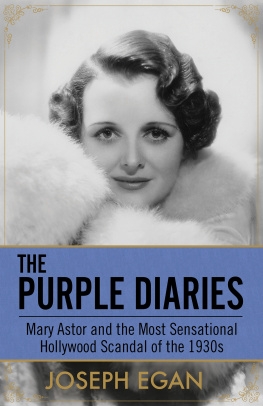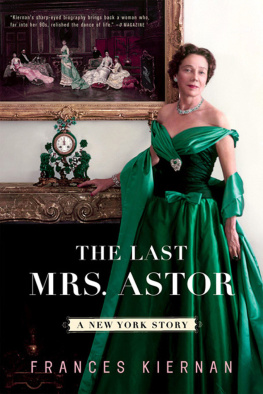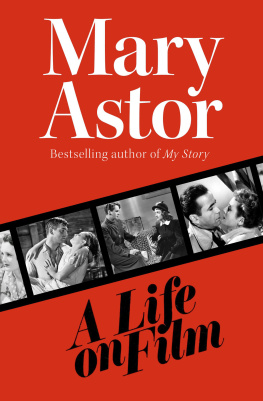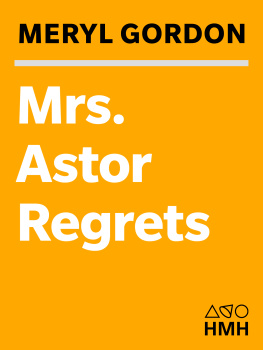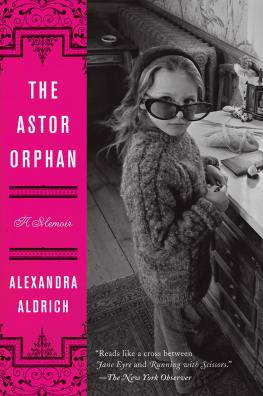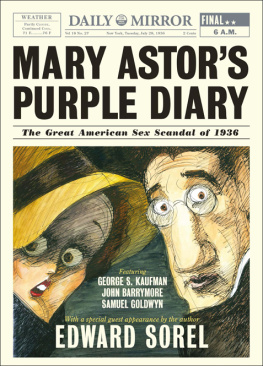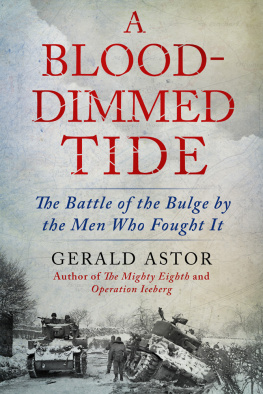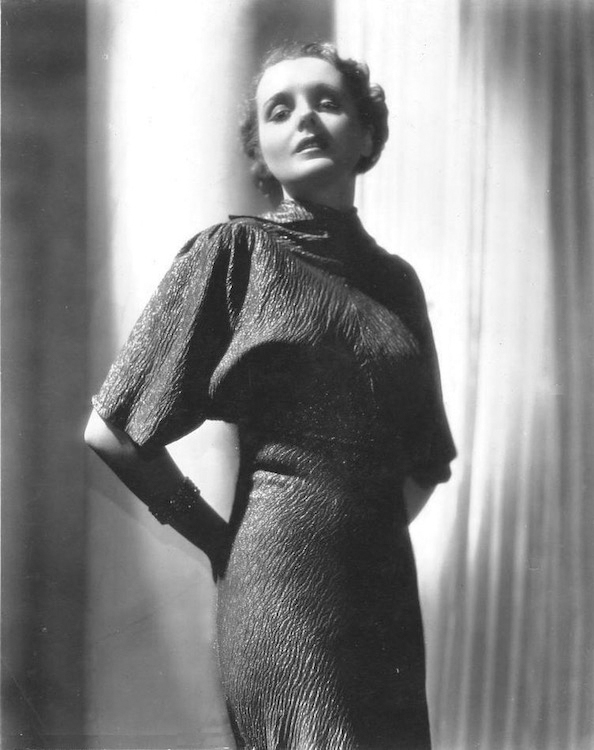Connect with us for information on new titles and authors from Diversion Books, free excerpts, special promotions, contests, and more:
Front cover image by A.L. Schafer
1936 was on its way to becoming a big year for Hollywood. Theatre attendance was up; the financial setbacks experienced during the early years of the Great Depression had pretty much subsided. No one in the industry wanted to rock the boat. During the summer of 1936, though, the boat was rocked when a Hollywood scandal exploded across front pages of newspapers all over America. It was a story so big, so juicy, and so filled with the intimacies of the film colony that for weeks it joined Hitlers Berlin Olympics and the Spanish Civil War on the front pages of newspapers throughout the English-speaking World.
The reasons for this brouhaha were two ledger books that a famous actress used as a diary. It was a story about an actress, her paramour, and a husband she no longer loved. It was a story of jealousy, pride, courage and single-minded determination. The name of the actress was Mary Astor, and the sensation that those two ledger bookswhich came to be known as the Purple Diariesstirred up was the biggest scandal Hollywood had seen for more than a decade, or would see again for twenty years. In short, it was the stuff of legend.
What is life all about? Maybe Ill be able to figure it out some day.
Mary Astor, October, 1934
M.A.
M.R.
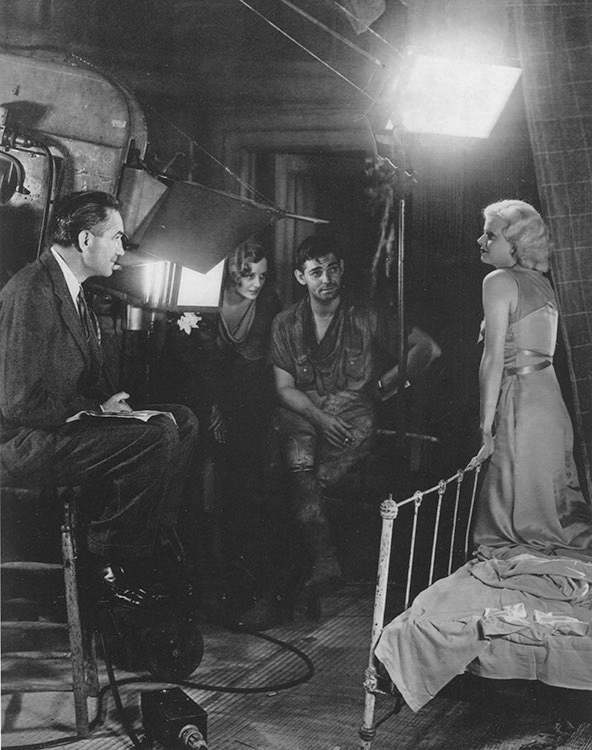
Set of Red Dust. L to R: Director Fleming, Astor, Clark Gable, and Jean Harlow.
Because my mother, Frances Roh Yang, is Mary Astors first grandchild, every year while I was growing up, for the holidays, the family would gather around the television to watch a VHS of Meet Me In St. Louis. In the film, when Mama March sits at the piano and sings with Papa Smith, my mother would announce:
That is your great-grand-mommy. Your grammys mama.
Mary Astors role was small, but rooted the film in the way an idyllic mother roots any householdconstant, ever present. Somehow, the woman in that Technicolor picture connected me, as a kid in Utah, to this glittering, glamorous, thrillingly happy world of celluloid dreams. This saint of motherhood loomed over my childhooda protective, soothing, caramel-voiced ghost.
Thus, it seemed like some sort of duty to destiny that in school I was always involved in theatre. In a small twist of fate, I ended up designing costumes for a show and soared down a path of costume designand somehow, in 2003, I ended up attending the Fashion Institute of Technology in New York City.
As a college student, struggling to find my identity and inspiration for countless student collections, I returned to the stories and pictures of my great-grandmother. I discovered an old movie picture store where I would stop between fabric pickups and purchase photos of my great-grandmother doing costume tests, glamour shots, or between takes with Clark Gable and Jean Harlow.
She was my protector, my reminder to return to the core of my artistic strength whenever I was lost. I binged on every film of hers I could find. In New York, I could even catch screenings of her films in big screen theatres, where I could drag my friends and convince them of her talent. She proved a muse, a glittering star from whom I drew inspiration.
Eventually, I stumbled upon a Los Angeles Times Web page that profiled a wild and scandalous court case in which Mary Astor was involved, fighting over custody of my Grammy Marylyn. Since I kept a blog, I wrote about my discovery. This wasnt a custody case; this was a sensationand it was in a language that many of my friends and peers could understand: the language of tabloid media and scandalous thrills. During that trial Mary Astor went from being a saint to being a star.
Through the Internet, I found myself being contacted for interviews about my great-grandmother from movie buffs around the world. And then, from the family grapevine, I found out that my grandmother was talking to a writer who was interested in writing a book about that scandal; the biggest Hollywood scandal of the 1930s.
My grandmother kept up a lively exchange with this writer and, every so often, forwarded me some of their notes before finally connecting us directly. When Joe and I started corresponding I was thrilled to have discovered, at the heart of it, another Mary Astor fanbut one who was deeply connected to the era in which she livedin short, a film historian. He was attempting to chronicle one of Mary Astors greatest starring roles, a role that dominated the front-page headlines of every national newspaper for weeks. It wasnt a film, but it would have made a great one. It was a high-octane courtroom drama with a stunning lead actress and handsome male leadmy great-grandfather, Franklyn Thorpe. It had sex, booze, and a cast of gossiping nannies, combative attorneys, flimsy flings and, at the center of it all, a radiant four-year-old girlmy wide-eyed baby grammy.
When I traveled to upstate New York to visit Joe and his wife, to share with him some pictures and scanned memorabilia, I was surprised to discover that he had embarked on his endeavor to chronicle this courtroom saga over ten years earlier. He shared a stack of four-inch-thick binders carefully archiving almost every newspaper article written about the case as well as scores of paparazzi and studio photos from the period. Here was someone who knew more about my great-grandmother than I did.
Mary Astor may not have been the greatest actress of all timebut her story is the fullest breath of every actress. She lived her archetype as an artist through and through. She was discovered as a teenager in a beauty contest, shimmered in silent films, and survived into the talkies. Her first husband died tragically in a plane crash in 1930, and her second embroiled her in a tabloid custody battle that set the stage for how every star today lives under the media microscope. Her second act in films was her artistic peak; she won her Oscar and finally got parts where she could dazzle. And then she prematurely aged out of her glamorous roles and, in countless MGM films, became the mother on film that she could never be in real life. She left Hollywood, returning to her craft in theatre and the early years of television before finally discovering writing. She was a tempestuous woman who was torn between her work, her family, and her lifea life that no one could say was not fully lived. In this book, we get a glimpse into the starring role she never got to play on screen, and that ride, from beginning to end, is thrilling.

